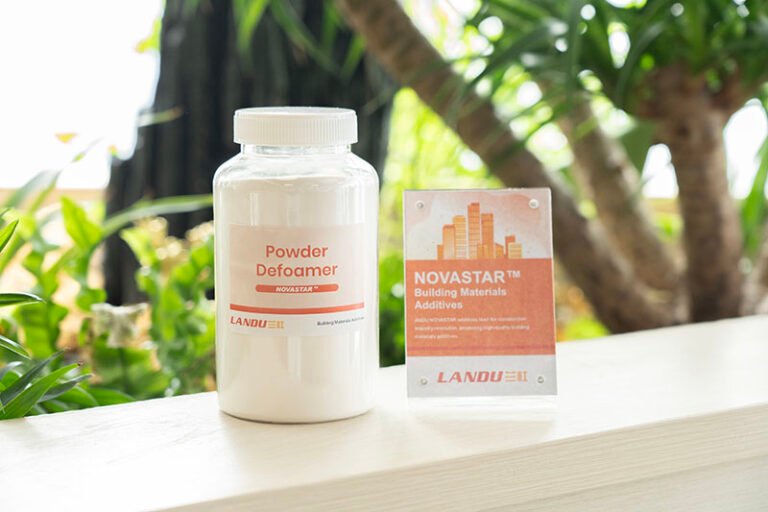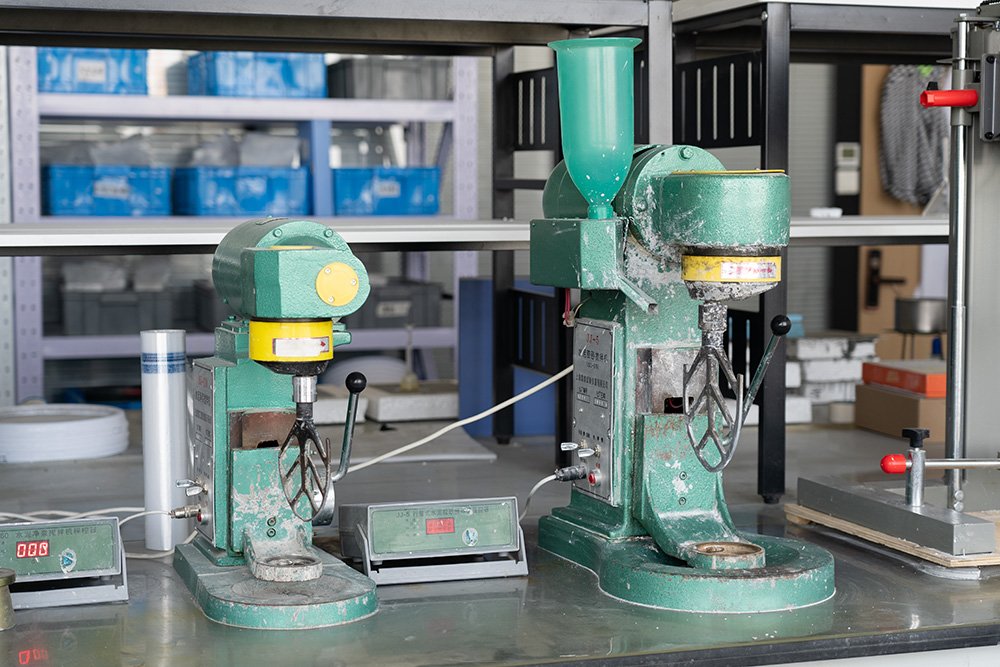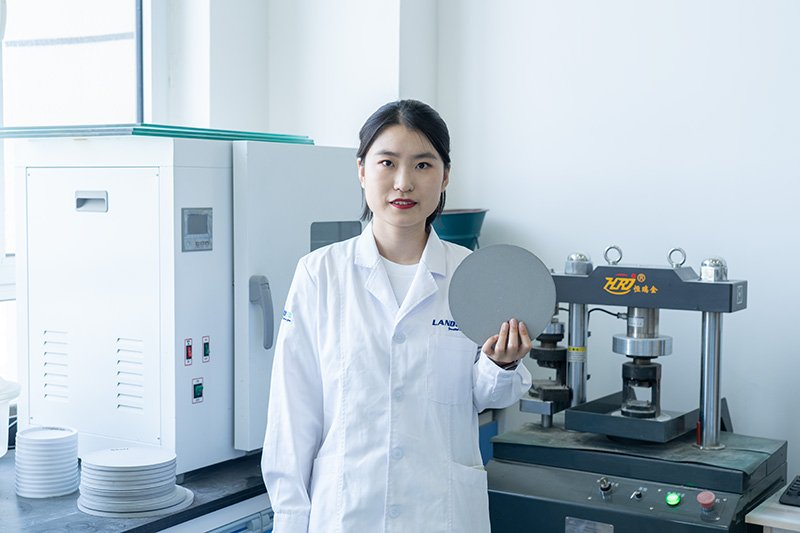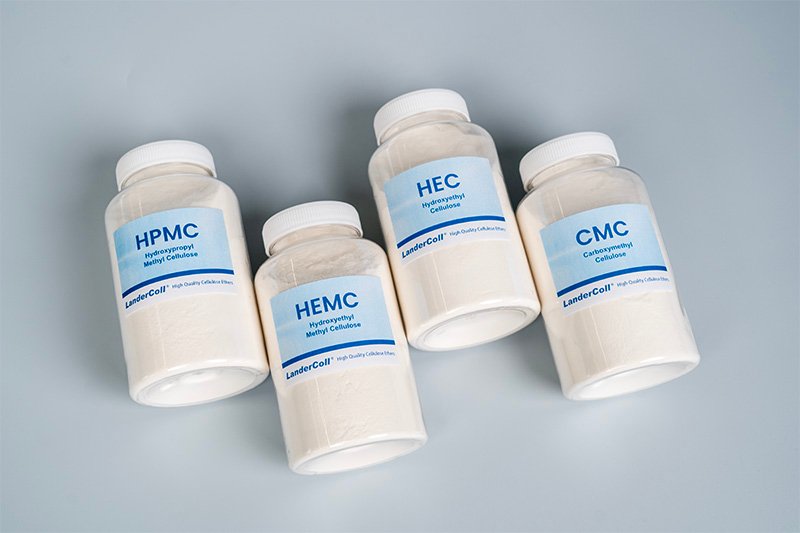LANDU organizes dry mix mortars into nine primary usage groups, each tailored to address unique on-site demands and efficiency needs:
- Ceramic Tile Adhesive (CTA)
- Gypsum Binder
- Joint Filler
- Masonry Mortar
- Flowable Mortar (self-leveling, grouts)
- Waterproof Mortar
- Thermal Insulation System (EIFS)
- Plaster
- Wall Putty
In the sections that follow, we detail how LANDU’s cellulose ethers (HPMC, MHEC) and Redispersible Polymer Powders (RDP) boost functionality across these areas, complemented by tips for product choices and integration strategies.
1. Hydroxypropyl Methyl Cellulose (HPMC): The Agent for Moisture Control and Ease of Use
Role and mechanisms
HPMC serves as a vital component in dry mix mortars, expertly balancing hydration and flow characteristics:
- Moisture preservation: It slows down water loss and tempers absorption by the base material, ensuring steady cement curing while minimizing shrinkage in the plastic phase, voids, and initial fine fractures.
- Flow dynamics and shear response: It thickens mixtures when idle, eases under pressure for smooth spreading or pumping, and quickly regains structure to prevent drooping on upright surfaces.
- Handling experience: By creating subtle slippery layers around particles, it reduces application effort, enhances even distribution, and yields sharper lines and polished finishes.
- Adjustability window: In warm or dry environments, enhanced moisture holding prolongs the period for repositioning and avoids premature crusting, facilitating precise installation and refinement.
Performance outcomes
- Enhanced, consistent curing leads to quicker initial hardening and sustained resilience over time.
- More reliable and fluid manipulation regardless of environmental or surface variations.
- Superior bonding through a unified structure and effective hydration at contact points.
Where HPMC shines (examples)
- Tile adhesives: Superior repositioning, initial stickiness, and resistance to sliding.
- EIFS base/finish layers: Even curing in slender applications, fewer surface voids, and managed working duration.
- Putty and topcoats: Elevated-thickness variants offer exceptional evenness, droop prevention, and fracture toughness.
Note on MHEC
MHEC (methyl hydroxyethyl cellulose) delivers comparable advantages but with subtle variations in thermal gel point and texture; formulators often blend HPMC and MHEC to precisely calibrate working periods, application sensation, and slump resistance suited to particular weather and base conditions.
2. Redispersible Polymer Powder (RDP): The Enhancer for Resilience and Bonding
Role and mechanisms
RDP particles dissolve in liquid and merge as they dry, producing a pliable, robust polymeric network amid the inorganic components:
- Bonding: These networks merge with cement products and underlying materials, boosting pull-off strength—both fresh and post-exposure (to moisture, warmth, or freeze cycles).
- Elasticity and fracture prevention: The material spans tiny gaps and cushions stresses from temperature shifts, weight, and contraction.
- Unity and initial grip: It strengthens the mix in its wet and early-set phases, aiding neat processing and stronger connections with less-porous bases.
Key application benefits
- Tile adhesives: Superior attachment across various tiles and foundations; extended usability when combined with HPMC/MHEC; less void formation.
- Wall putty and plasters: Greater internal integrity, refined surfaces, and diminished cracking from drying.
- EIFS: Firmer hold on insulating panels, elevated resistance to impacts and environmental wear, and enduring exterior protection.
The Synergy of HPMC/MHEC + RDP in Modern Mortars
Why the combination works
- Internal framework: HPMC/MHEC regulates liquid spread and wet-state behavior, allowing RDP to create uninterrupted, evenly spread films. This polymeric web then connects cured elements, eases tension points, and amplifies overall robustness.
- Real-world impacts: Prolonged usability without settling; better saturation of impermeable areas; stronger holds after thermal or freeze stresses; easier spreading and superior results.
- Customization: For upright applications (like CTA or renders), HPMC/MHEC ensures no-droop stability, while RDP protects attachment quality and adaptability.
Application-by-application optimization
1) Ceramic Tile Adhesive (CTA)
- Goals: Droop-free vertical application, extended usability, robust bonding post-testing, even ridging and coverage.
- HPMC/MHEC: Supplies hydration control, responsive thickening for slide resistance, and velvety spreading. Maintains pattern integrity for uniform tile contact.
- RDP: Increases pull strength (fresh and tested) and adaptability for oversized tiles, underfloor heating, or outdoor settings.
- Typical starting points: HPMC/MHEC 0.2–0.6% of dry blend; RDP 2–5% (elevated for outdoor or non-porous tiles). Refine with starch additives for extra responsiveness and a foam suppressant for bubble management.
2) Gypsum Binder (skim/finishing coats)
- Goals: Polished results, regulated hardening, even moisture release, reduced imperfections, simple abrading.
- HPMC/MHEC: Holds water to balance base pull and thermal rise, boosts slide, and cuts flaws on the surface.
- RDP: Selective for boosted unity or when trials require advanced capabilities.
- Typical starting points: HPMC/MHEC 0.10–0.40%; RDP 0.5–2.0% if required; add a delay agent to match desired working span.
3) Joint Filler (tile joints, drywall compounds, grouts)
- Goals: Seamless insertion with minimal contraction, moisture stability, fracture toughness, simple shaping, and firm hold.
- HPMC/MHEC: Manages evaporation, steadies the mix, and enables droop-free vertical use.
- RDP: Contributes adaptability and attachment for areas prone to shifts or dampness.
- Typical starting points: HPMC/MHEC 0.15–0.40%; RDP 1–3%. Include germ inhibitors and water-repellent agents for humid zones.
4) Masonry Mortar (block/brick laying)
- Goals: Usability and mix lifespan, hydration for absorbent blocks, sufficient durability, lowered salt blooming.
- HPMC/MHEC: Boosts moisture holding and flexibility, improving efficiency and connection while avoiding weak seams.
- RDP: Valuable for superior grip and bending resistance, particularly in slim-layer or challenging setups.
- Typical starting points: HPMC/MHEC 0.10–0.30%; RDP 1–3% based on durability and bend targets.
5) Flowable Mortar (self-leveling underlayment, grouts)
- Goals: Excellent spread without separation or liquid rise, border firmness, few surface holes, rapid initial hardness.
- HPMC/MHEC: Reduced-thickness types secure flow, block separation, and polish the top without excess density.
- RDP: Strengthens grip on solid bases and toughness against fine fractures from settling.
- Typical starting points: HPMC/MHEC 0.05–0.20%; RDP 1–3%; combine with PCE dispersants for desired liquidity.
6) Waterproof Mortar (tanking, negative/positive-side waterproofing)
- Goals: Compact, low-porosity structure with effective gap spanning and base attachment.
- HPMC/MHEC: Improves unity and polishing; oversees curing moisture to limit fine breaks that weaken barriers.
- RDP: Amplifies grip and pliability; essential for spanning gaps and endurance under pressure.
- Typical starting points: HPMC/MHEC 0.15–0.40%; RDP 3–6% per gap-spanning level and conditions.
7) Thermal Insulation System (EIFS: adhesives and base coats)
- Goals: Secure hold on insulating panels, collision toughness, weather endurance, manageable base layer for mesh inclusion.
- HPMC/MHEC: Offers usability window, vertical stability, and reliable curing in slim coats.
- RDP: Delivers attachment to EPS/XPS/MW panels and pliability/collision resistance in bases; vital for lasting exteriors.
- Typical starting points: HPMC/MHEC 0.20–0.50%; RDP 3–7% (adhesive/base), tailored to environment and panel.
8) Plaster (cement/lime/gypsum)
- Goals: Effortless spreading, less material loss, timed hardening, low fracturing, solid grip.
- HPMC/MHEC: Strengthens hydration control and responsiveness to curb settling; aids neat leveling and steady usability.
- RDP: Elective, depending on grip and adaptability requirements (for outdoor or variable temps).
- Typical starting points: HPMC/MHEC 0.15–0.40%; RDP 0–3% per class.
9) Wall Putty (cement-based or gypsum-based)
- Goals: Uniform evaporation, crack prevention, simple application, top-notch polish, firm hold, and abrading ease if needed.
- HPMC/MHEC: Directs evaporation and flow for smooth layers with reduced voids and breaks; enhances slide and vertical hold.
- RDP: Bolsters unity and grip, especially on compact bases or under tough testing.
- Typical starting points: HPMC/MHEC 0.20–0.50% (cement) or 0.10–0.40% (gypsum); RDP 1–3% where applicable.




